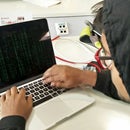Introduction: CODE RED
Environment Recognition and Safety Protocol for Firefighters.
A smart connected helmet with an Augmented Reality projection system comprising an OLED to display, a plethora of sensors to detect, the interior conditions of temperature, gas concentration and the user’s own vitals.
Step 1: Why & What CODE RED?
Problems faced by firefighters
- The existing methods of determining the rapidly changing interior site conditions are time-consuming and hazardous.
- Tool handling demands physical work and more access time.Finding an injured firefighter amidst a fire is very difficult with the current radio communication system.
- A significant number of fighters die by breathing in toxic gases.Poor understanding of the site temperature conditions and fire progression.
Proposed Solution - CODE RED
- A smart connected helmet with a plethora of sensors to detect, an Augmented Reality projection system comprising an OLED to display, the interior conditions of temperature, gas concentration and the user’s own vitals.
- Prototype Sensing the site temperature to understand the moving path and fire progressing direction. ( Temperature sensor)Sensing the concentration of various toxic and non-toxic gases for better understanding and to prevent death .(Gas sensor )Monitoring the physiological status of the fighter by sensing heart rate. (Pulse Sensor)Accelerometers to detect potential attacks, injuries and trauma when a debris collides with the user’s head.
- The data from the sensors are overlayed on the vision of the user without obstructing the user’s vision.
- The raw data is sent to the local cloud and transmitted to the nearest fighter when the other one is in danger.
The Future
- System expansion by monitoring additional surrounding parameters.
- Adding an FLIR Thermal Imaging sensor to overlay a thermal image of the surroundings with normal vision.Integrating our system to the current emergency wireless network.
- The location of the downed firefighters can be found using Trilateration aid rescue.
- Introducing a sphero BB-8 type Bot for analysing and providing accurate data at the fire site for helping the firefighters high sensibly.
Step 2: Overall Architecture & CAD Working
Step 3: Components Used
1 × Gas sensor
1 × Temperature sensor
1 × OLED Display
1 × Particle Photon
1 × Augmented Reality Display Enclosure
1 × Accelerometer
1 × Power supply
Step 4: Temperature Sensor
Thermistors are thermally-sensitive resistors whose prime function is to exhibit a large, predictable and precise change in electrical resistance when subjected to a corresponding change in body temperature. Negative Temperature Coefficient (NTC) thermistors exhibit a decrease in electrical resistance when subjected to an increase in body temperature and Positive Temperature Coefficient (PTC) thermistors exhibit an increase in electrical resistance when subjected to an increase in body temperature.
We used a temperature sensor and started the basic coding to display the variations.
Step 5: Gas Sensor
A gas detector is a device that detects the presence of gases in an area, often as part of a safety system. This type of equipment is used to detect a gas leak and interface with a control system so a process can be automatically shut down. A gas detector can sound an alarm to operators in the area where the leak is occurring, giving them the opportunity to leave. This type of device is important because there are many gases that can be harmful to organic life, such as humans or animals.
Detectors can be used to detect combustible, flammable and toxic gases and oxygen depletion. This type of device is used widely in industry and can be found in locations, such as on oil rigs, to monitor manufacture processes and emerging technologies such as photovoltaic. They can be used in firefighting.
We did Basic coding for gas detection.
Step 6: Accelerometer
An accelerometer is a device that measures proper acceleration ("g-force"). Proper acceleration is not the same as coordinate acceleration (rate of change of velocity). For example, an accelerometer at rest on the surface of the Earth will measure an acceleration g= 9.81 m/s2straight upwards. By contrast, accelerometers in free fall(falling toward the centre of the Earth at a rate of about 9.81 m/s2) will measure zero.
we are done coding for 3-axis accelerometer and obtained various data's.
Step 7: Augmented Reality Based OLED Display
we made our own augmented reality setup after watching some demos on youtube.
Step 8: Cloud Computing
We used "photon" for cloud computing. The Photon is a tiny Wi-Fi development kit for creating connected projects and products for the Internet of Things. It's easy to use, it's powerful, and it's connected to the cloud.
Step 9: Connecting & Interfacing
Finally, we combined and interfaced everything.
HOORAY!!!
OUR PROJECT IS READY...
Feeling great, After doing a small part of help for the firefighter's community.
We are working on( V2.0) it further after being recognised as the best project through a hardware community(They really motivated in greater manner).



